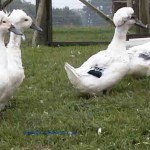farm
Image of a corn earworm by Sarah from Statesboro GA, USA (Corn Earworm on corn ear) [CC BY 2.0 (http://creativecommons.org/licenses/by/2.0)], via Wikimedia Commons
New research published in the Proceedings of the National Academy of Sciences shows that bats are important nocturnal predators of insects that would otherwise attack crops. In addition, bats help to protect crops from fungal infections brought on by pests and are important pollinators. According to the new research, the pest-control services provided by bats for corn crops alone is worth about 1 billion…
Image of sheep from Wikimedia Commons
Insulin is a major hormone responsible for regulating blood sugar. Its main function is to lower sugar by increasing glucose uptake into muscle and fat cells. Insulin resistance is the hallmark of type 2 diabetes and occurs when tissues in the body are not able to respond to insulin resulting in sustained elevations in blood sugar, also known as hyperglycemia.
An alternative mechanism for lowering blood sugar is muscle contraction as it stimulates a pathway distinct from insulin in the muscles to cause glucose uptake from the blood. Exercise…
Image from www.chow.com
Did you know that the typical Thanksgiving day broad-breasted white turkey develops in as little as 136 days (on average)? This remarkably quick development is a result of years of selective breeding. The average turkey in 1929 was only about 13 pounds, whereas modern turkeys average around 30 pounds with much of the weight centered in the breast muscles.
The Poultry Science Association claims that this breeding program has resulted in skeletal problems as muscle growth outpaces bone growth, heart problems, and a lower ability to mount immune responses to…
Image of cricket chips called "chirps" from Six Foods. (http://www.sixfoods.com/#product)
Crickets are the first insect to now be farmed for human consumption in the United States. I'll admit the thought of snacking on cricket flour-based chips is not exactly appetizing. But the process of farming insects over more traditional livestock seems to be less wasteful. Insect farming is a more efficient way of producing dietary protein as it takes much less feed and water to raise insects as compared to cattle. In addition, greenhouse gas emissions from crickets are much lower than…
So I somehow forgot to mention when I went on maternity leave and promised to post on Thursdays that I meant I would start this Thursday, since I was on vacation last week. Sorry 'bout that. I will shamelessly blame the baby and sleep deprivation again.
We spent much of last week visiting family near Boston, which was lovely - the transition with K. and C. really took it out of us. I'm not a high-stress person, I tend to be pretty relaxed, but we really needed a break after two very hectic weeks and a lot of emotion. Among other things, we had sent K. and C. home two…
Apologies to everyone for the radio silence - lots of stuff going on here and the blog has been horribly neglected. Between trying to get the final garden push done, a bunch of goat birthing (including four beautiful babies yesterday for Eric's 42nd birthday - Urania gave us Tybalt and Mercutio in the wee hours while Calendula delivered Beatrice and Benedick), a lot of legal and medical proceedings involving C. and K, our foster sons, and the end-of-school stuff (Eli is transitioning from the program for kids with autism that he's been in since kindergarten to a new program for middle…
I really wish I could share pictures of K. and C., who are having their first farm springtime, complete with baby goats, dam building in the creek, their own gardens, finding nests of newly hatched chicks, catching toads and salamanders, eating salads made with wild greens they collect themselves, but that would violate their privacy. Still, I think I can give you at least a sense of the Hun-like decimation of food that goes on in my house with six little guys - they all stuck their hands in over the jambalaya to show how a pan the size of Idaho makes just over one meal:
…
Spring is a trick of the light - it should be, after all, since ultimately the shift of seasons is about angles and sun. At some point in March the light changes - a new "certain slant of light" and thus, spring is here. It will be a while most years before the green and the daffodils or even the spring peepers arrive in upstate NY, but in the meantime, the sky and the air and the angle of sun says spring.
Seed starting is in full swing now and I sometimes feel I spend far too many of my days elbow deep in potting soil - but the smell of moist compost is energizing as well. It is…
I won't usually publish ID updates here, but I did want to remind everyone who wants to participate that this is going on - please feel free to jump in, post updates at your blog, on facebook or in the comments of the update threads (posted on Fridays) at www.sharonastyk.com. In the meantime, here's the first one:
The weather of our discontent continues - weirdly warm for upstate NY in winter, plants and animals blooming or returning too early. The pussywillows have catkins, my elderberries have green buds, the daffodils are up and we saw a red-winged blackbird yesterday - all of which are…
Meg emails to ask me "How much work is small-scale farming, anyway?" I want to farm and I'm planning on trying it out over the summer as an intern, but what I'm worried about is not being able to keep up with everyone else. I'm healthy and reasonably energetic, but everyone makes it sound so hard! Should I even try?"
Well first of all, I think Meg is doing exactly the right thing in trying it out. The best way to understand whether you are suited to small-scale agriculture is to get some experience, idealy on several different small farms that do the kinds of things you want to do.…
By Elizabeth Grossman
While the rest of the country has been experiencing an epic heat wave, in the Pacific Northwest where I live, thus far the summer has been unusually cool. One consequence of the cool weather is a slow-to-appear local tomato crop, made evident to consumers by some remarkably high prices. A pint of organic cherry tomatoes at my neighborhood market recently jumped more than a dollar within a week to $4.99, prompting me to wonder precisely what goes into the price of tomatoes.
Regional growers, distributors, and retailers all told me that prices are typically determined by…
I have one more crazy week involving travel and lots of other responsibilities, culminating in our final home visit in our foster care certification (as some of you will recall, we had a tough visit our second time with a social worker who was totally appalled by the farm - our social worker's supervisor kindly agreed to come out so that we won't have to deal with shifting standards (our own social worker is totally cool with it) and can be clear what we need to do and what is ok), so there will be little content this week.
So I'm asking y'all to provide content - tell me what you are doing…
One of the projects we're working on is ways to bring more people to our farm. A lot of folks want to see what we're doing, and we've been contemplating open farm days, and possible ideas for classes we might teach. Well, while Eric and I were discussing it the other night, we came up with the idea of the "realistic farm tour" that gives people a real sense of what actually goes on on a farm - we could market ourselves a unlike all those other agritourism ventures that sell the dream - we sell the reality! Here are some of the activities we are sure people would pay us to do!
"Explore the…
These were taken before the 18 inches of snow that fell the other day, so you can actually see the ground, but the scene is still basically the same - white, with scattered critters. We're all definitely starting to dream of spring!
The creek in winter
Asher at the Creek
Isaiah, finding material to repair our (very primitive) footbridge
Hauling wood is a daily chore. When the snow is falling hard, my fuzzy, frosty spouse looks vaguely like a yeti after a few loads ;-).
With all this weather, it is good thing all the stuff in the root cellar is still holding up! At least we don't have…
I once wrote an essay about my son Isaiah's wish for a farm. He has a farm, of course, but he also dreams of a different one, the one in his imagination. What was funny was that all the adults that saw his wish understood it so very well. Many people tell me how much they want a farm. But other people show me that farms are easier to find than you think, even if they aren't perfect. These are all real people, who I know. As i start our garden design class today, I started thinking about all the farm dreams I've known!
I know a man who wanted to start a farm. So he worked and saved for…
We almost did it. We really did. We went so far as to get mortgage pre-approval, meet with a builder about the costs of repairing the barn and the house, and make an appointment to make a written offer. And we decided to stay here.
There were several reasons for doing so. The first was that our offer would be contingent, and we thought there was a better than 50-50 chance that the sellers might well sell the house out from under us - that is, since we didn't per se want to sell the house, but rather to buy *this particular different house* the fact that we're in no way ready to show (my…
The first thing you need to know about my farm is that it is huge. I mean enormous - by world standards. The vast majority of the world's farms - more than 80%, are very small farms, of less than 2 hectares (about 5 acres), and they produce the majority of the world's staple crops and calories.
I suspect most folks in most of the Global North will find that a little surprising. The term "farm" in the US tends be applied most often to very large farms. We have a strong internal sense that small scale agriculture is particularly unsuited to growing staples. Most small farms in the US…
The Sharks and the Jets are fighting over by the compost pile. Well, ok, maybe not quite, but it has that feel to it. You see, we have two street-gangs of ducks. The first ones, Pekins and one ratty looking Rouen who is shooting for the "oldest living duck record" have been around for a bit. The Rouen was the only duck on our farm for about two years, after his girlfriend succumbed to the siren song of the creek and got eaten by something. Then, this year on Christmas morning (which would make a great Christmas miracle story if a. I were a Christian and b. it weren't ducks ;-)), a group…
Nine years ago today we moved to our farm. We brought with us some boxes of stuff, some furniture, four cats, our then 15-month old son (Eli, now 10 and 5' tall), Simon, packed conveniently in my pregnant belly, and my Mom (who went home after a day or two of helping us with the little guy). I was 29, Eric was just about to turn 31, and we were about as unprepared for life on a farm as any two (or three) people could be.
Eric had grown a garden once or twice with his Mom as a kid in various apartment buildings. I'd had balcony gardens all through college and grad school, and once a year,…
When we bought the property, the creek was frozen over, and from the property survey, we weren't entirely certain that it would belong to us. We never realized that the pretty little body of water that passed along the north side of the house would become the center of four worlds.
For the first few years that we lived here, we enjoyed the creek - my toddler children loved to visit with parents in tow, picking up stones or chasing frogs during summer, when the creek sank down to manageable levels. We enjoyed listening to its music through the open windows at night. We watched the birds…



